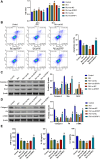Ginsenoside Rb1 affects mitochondrial Ca2+ transport and inhibits fat deposition and fibrosis by regulating the wnt signaling pathway to treat rotator cuff tears via docking with SFRP1
- PMID: 39617900
- PMCID: PMC11610219
- DOI: 10.1186/s10020-024-01009-0
Ginsenoside Rb1 affects mitochondrial Ca2+ transport and inhibits fat deposition and fibrosis by regulating the wnt signaling pathway to treat rotator cuff tears via docking with SFRP1
Abstract
Background: Rotator cuff tears (RCTs) are among the most common musculoskeletal disorders that affect quality of life. This study aimed to investigate the efficacy of ginsenoside Rb1 in RCTs and the mechanisms involved.
Methods: First, a fibrotic model of FAPs was induced, and FAPs were cultured in media supplemented with different concentrations of ginsenoside Rb1. Next, a rat model of RCTs was constructed and treated with ginsenoside Rb1. Molecular docking was subsequently utilized to detect the binding of ginsenoside Rb1 and SFRP1. Finally, SFRP1 was knocked down and overexpressed in vivo and in vitro to investigate the mechanism of ginsenoside Rb1 and SFRP1 in RCTs.
Results: Compared with the Normal group, FAP viability was decreased, but Collagen II, FN and α-SMA levels were increased in the Control group. After treatment with different concentrations of ginsenoside Rb1, FAP viability increased, but Collagen II, FN and α-SMA levels decreased. Among them, 60 µM ginsenoside Rb1 had the best effect. In vivo experiments revealed that ginsenoside Rb1 improved RCTs in rats. Molecular docking revealed the binding of ginsenoside Rb1 to SFRP1. Additionally, SFRP1 levels were lower in the Control group than in the Normal group. After treatment with ginsenoside Rb1, SFRP1 levels increased. In vivo, overexpressing SFRP1 along with ginsenoside Rb1 treatment further alleviated tendon tissue fibroblast infiltration and fat accumulation and further reduced the expression of Collagen II, FN, and α-SMA. In vitro, overexpressing SFRP1 along with ginsenoside Rb1 treatment further decreased the expression of CaMKII, PLC, PKC, Wnt, and β-catenin, further decreased the Ca2+ fluorescence intensity and mitochondrial length, increased the red/green intensity, and decreased the MitoSOX fluorescence intensity. Additionally, overexpressing SFRP1 along with ginsenoside Rb1 treatment further increased cell proliferation, decreased apoptosis, reduced the protein expression of Collagen II, FN, and α-SMA in muscle tissue, and further reduced the levels of TNF-α, IL-1β, and IL-6 in the cell supernatant.
Conclusions: Ginsenoside Rb1 inhibited the activation of the Wnt signaling pathway by promoting SFRP1 expression, thereby inhibiting mitochondrial function and Ca2+ absorption to treat fat infiltration and muscle fibrosis caused by RCTs.
Keywords: Ca2+; Ginsenoside Rb1; Rotator cuff tears; SFRP1; Wnt.
© 2024. The Author(s).
Conflict of interest statement
Declarations. Ethics approval and consent to participate: The study was approved by the Animal Welfare Committee of Central South University (No. 2019sydw0198). Consent for publication: Not applicable. Competing interests: The authors declare no competing interests.
Figures







Similar articles
-
Effects of TNF-α on Behaviour and Inflammation in Rats with Rotator Cuff Injury through NGF.Discov Med. 2024 Jun;36(185):1241-1249. doi: 10.24976/Discov.Med.202436185.114. Discov Med. 2024. PMID: 38926110
-
SFRP1 reduces neutrophil infiltration and inhibits the Wnt/β-catenin pathway to alleviate oral submucous fibrosis.In Vitro Cell Dev Biol Anim. 2024 Oct;60(9):1034-1045. doi: 10.1007/s11626-024-00945-9. Epub 2024 Jul 17. In Vitro Cell Dev Biol Anim. 2024. PMID: 39017751
-
Parathyroid Hormone Inhibits Fatty Infiltration and Muscle Atrophy After Rotator Cuff Tear by Browning of Fibroadipogenic Progenitors in a Rodent Model.Am J Sports Med. 2023 Oct;51(12):3251-3260. doi: 10.1177/03635465231190389. Epub 2023 Aug 24. Am J Sports Med. 2023. PMID: 37621014
-
Mitochondria Isolated From Bone Mesenchymal Stem Cells Restrain Muscle Disuse Atrophy and Fatty Infiltration After Rotator Cuff Tears.Am J Sports Med. 2025 Apr;53(5):1171-1183. doi: 10.1177/03635465251323001. Epub 2025 Mar 15. Am J Sports Med. 2025. PMID: 40088076
-
Pharmacological Mechanism and Drug Research Prospects of Ginsenoside Rb1 as an Antidepressant.Antioxidants (Basel). 2025 Feb 19;14(2):238. doi: 10.3390/antiox14020238. Antioxidants (Basel). 2025. PMID: 40002422 Free PMC article. Review.
References
-
- Ainsworth R. Physiotherapy rehabilitation in patients with massive, irreparable rotator cuff tears. Musculoskelet Care. 2006;4(3):140–51. - PubMed
-
- Bedi A, Bishop J, Keener J, Lansdown DA, Levy O, MacDonald P, Maffulli N, Oh JH, Sabesan VJ, Sanchez-Sotelo J, et al. Rotator cuff tears. Nat Rev Dis Primers. 2024;10(1):8. - PubMed
-
- Bernichtein S, Peltoketo H, Huhtaniemi I. Adrenal hyperplasia and tumours in mice in connection with aberrant pituitary-gonadal function. Mol Cell Endocrinol. 2009;300(1–2):164–8. - PubMed
-
- Chen Y, Li Y, Zhu W, Liu Q. Biomimetic gradient scaffolds for the tissue engineering and regeneration of rotator cuff enthesis. Biofabrication. 2024; 16(3). - PubMed
MeSH terms
Substances
Grants and funding
LinkOut - more resources
Full Text Sources
Medical
Miscellaneous

